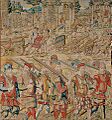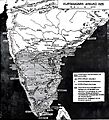Battle of Raichur facts for kids
Quick facts for kids Battle of Raichur |
|||||||
|---|---|---|---|---|---|---|---|
 Raichur Fort |
|||||||
|
|||||||
| Belligerents | |||||||
| Commanders and leaders | |||||||
|
Krishnadevaraya
Cristovão de Figueiredo |
Ismail Adil Shah Mirza Jahangir † Salabut Khan (POW) Asada Khan |
||||||
| Strength | |||||||
| Casualties and losses | |||||||
| 16,000 soldiers killed (contemporary sources) | Unknown but heavy | ||||||

The Battle of Raichur was a major fight in 1520 in Raichur, India. It was fought between the Vijayanagara Empire and the Sultanate of Bijapur. The Vijayanagara forces won a big victory. They defeated the Bijapur ruler and pushed his army back across the Krishna River. This battle was a very important event in the history of southern India.
Contents
Why the Battle Happened
The Raichur Fort Dispute
The Raichur Fort was built in 1284 by King Rudra of the Kakatiya kingdom. After the Kakatiyas declined, the fort became part of the Vijayanagara Empire. For about 200 years, different rulers fought over this fort. It was a very important place to control.
In 1323, Muhammad bin Tughluq captured the fort. Later, the Bahmani Sultanate took it in 1347. Saluva Narasimha Deva Raya tried to get Raichur back for Vijayanagara, but he failed.
The Horse Betrayal
The main reason for the Battle of Raichur started in 1520. The Vijayanagara ruler, Krishnadevaraya, sent a man named Seyed Maraikar to Goa. Maraikar was supposed to buy horses for the army with a lot of money.
But Maraikar betrayed Krishnadevaraya. He took the money and went to Adil Khan, the ruler of Bijapur. He offered his services to Adil Khan instead. Krishnadevaraya demanded that Maraikar and the money be returned. Adil Khan refused. This made Krishnadevaraya very angry.
During a time of peace, Krishnadevaraya secretly got his army ready. He planned a huge attack on the Raichur area, which was controlled by Bijapur.
The Battle of Raichur
Armies Prepare for War
The battle took place in Raichur. The armies of Krishnadevaraya and the Sultanate of Bijapur faced each other. Saluva Timmarusu was the main commander for the Vijayanagara army.
According to old records, the Vijayanagara army had about 32,600 cavalry (soldiers on horseback) and 551 elephants. The Bijapur Sultanate had about 7,000 cavalry and 250 elephants. There are different ideas about how many foot soldiers each side had. Some say Krishnadevaraya had over 700,000 infantry.
Ismail Adil Shah, the Bijapur ruler, moved his army to help Raichur. His army had 120,000 foot soldiers, 18,000 horses, and 150 elephants. Even though he had fewer soldiers overall, his army had a big advantage in artillery (cannons).
Crossing the Krishna River
Adil Shah reached the Krishna River, but Vijayanagara troops blocked his way. He managed to cross the river and moved towards Krishnadevaraya's camp. Both armies got ready for battle and spent the night prepared to fight.
The Fight Begins
The next morning, Krishnadevaraya ordered his army to attack. At first, the Vijayanagara forces made good progress. But then, the Bijapur army fired their heavy cannons. This caused the Vijayanagara soldiers to retreat in confusion.
Krishnadevaraya quickly gathered his troops. He encouraged them, saying they should die as soldiers rather than run away. He called for his loyal officers. Together, they charged the enemy again. This surprise counter-attack made the Bijapur army panic and retreat.
Victory for Vijayanagara
The battle was very fierce, and many soldiers died on both sides. The Vijayanagara army lost over 16,000 soldiers. The Bijapur army also lost many, including Mirza Jehangir. Five important Bijapur captains, like Salabut Khan, were captured.
When Krishnadevaraya's generals saw the enemy retreating, they wanted to keep fighting. But Krishnadevaraya wanted peace. He ordered his troops to stop. After capturing the Bijapur camp, Krishnadevaraya took their supplies. He found 100 elephants, 400 cannons, tents, horses, and other animals. He released any captured women and honored the fallen soldiers.
Portuguese Help
A group of Portuguese soldiers, led by Cristovão de Figueiredo, also helped the Vijayanagara army. They used firearms, like matchlocks and arquebuses. These weapons helped them conquer the fortress. The Portuguese soldiers shot defenders from the walls, allowing the Vijayanagara army to get close and break down the fort's defenses.
The Bijapur Sultanate used many cannons, but the Vijayanagara Empire used them very little. Even so, the Vijayanagara Empire won the battle, showing great strength despite less firepower.
What Happened After the Battle
Taking Bijapur
After Raichur surrendered, Krishnadevaraya entered the city as a hero. He was very harsh towards the Bijapuri generals. Many of them lost their lands. Krishnadevaraya said that if Adil Shah came to him, bowed down, and kissed his foot, he would get his lands back. Adil Shah never did this.
Krishnadevaraya then led his army north to Bijapur and took control of it. When he returned to Vijayanagara, Ismail Adil Shah sent an ambassador. The ambassador asked for the captured items, including Raichur fort, to be returned. Krishnaraya agreed, but only if Adil Khan would show him respect.
A meeting was planned at Mudgal, but Adil Khan did not show up. Krishnadevaraya was furious. He marched on Bijapur. Adil Shah fled, and Krishnadevaraya took over the royal palace. Although he didn't plan to destroy the city, Bijapur still suffered damage.
Further Conflicts
Adil Shah tried to make a deal, but his ambassador, Asad Khan Lari, tricked Krishnadevaraya. He lied and said that Salabat Khan was to blame for the failed meeting. Believing the lie, Krishnadevaraya ordered Salabat to be executed. Asad Khan achieved his goal and escaped.
Angry about the ambassador's trick, Krishnadevaraya invaded Bijapur again. He caused destruction and captured some cities. At Sagar, he fought a large army and won another big battle. Krishnaraya also won battles at Shorapur and Kemba.
He freed three sons of a former Bahmani king who were held by Adil Shah. He made the oldest son the new king of the Deccan. This action made the five other Sultanates in the region even more against him.
Krishnadevaraya then started planning an attack on Belgaum, which Adil Shah controlled. But soon after, he became very ill and died in 1530 at the age of 45. His successor was Achyuta Deva Raya.
Long-Term Effects
Changes in Power
The Battle of Raichur had big effects. The Vijayanagara victory made the Adil Shah weaker. He started to make alliances with other Muslim rulers nearby. This victory also caused other Sultans in the Deccan to team up to defeat the Vijayanagara Empire.
The war also affected the Portuguese on the west coast. Their trade in Goa depended on support from the Hindu Vijayanagara Empire. So, when Vijayanagara grew stronger, Goa also grew.
A Lesson Not Learned
Some historians, like Richard Eaton, believe that Vijayanagara's victory at Raichur actually led to its downfall later. Krishnaraya won against an army with better weapons. Because of this, he might have thought that investing in new military technology wasn't that important.
However, the Sultans of the Deccan kept improving their weapons and learned better fighting tactics. This difference in military technology became a key reason why the Sultans defeated Vijayanagara at the Battle of Talikota 45 years later.
Images for kids




